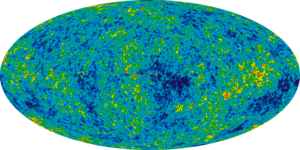| WMAP image of the (extremely tiny) anisotropies in the cosmic background radiation (Photo credit: Wikipedia) |
Where are we headed? Cosmologists don’t know for sure, but they’re trying to find out.
Recently, I went to the latest FREE physics dialogue at the Aspen Center for Physics -- “The Universe Caught Speeding: the Mystery of Dark Energy,” given by Dr. Dragan Huterer , Associate Professor of Physics at the. It was a great follow-up to the May 24th Aspen Center for Physics lecture, “TheDynamic and Evolving Universe”.
As predicted, based on my experience at previous Aspen Center for Physics lectures, I came away with more questions than answers, but I did learn a lot as well.
Dr. Huterer’s Presentation
This theory of “Geometry is destiny”, which acknowledges the existence of Dark Matter as well as regular matter, relies on several assumptions, one of which is that gravity is the ONLY large range force that exists.
Actual observations, however, have cast doubt on the assumption that that gravity is the only large range force in existence and suggest that the universe is NOT made up of matter only.
In the 1990’s, cosmologists and astrophysicists theorized and discovered observationally through the study of distant supernovae and several other methods, that the expansion of the universe is in fact accelerating and that some repulsive large range force must be causing it to do so.
Current Theories About the Expansion of the Universe
According to Wikipedia, there are two proposed forms for dark energy, the cosmological constant, “a constant energy density filling space homogeneously,[3] and scalar fields such as quintessence or moduli, dynamic quantities whose energy density can vary in time and space.” - http://en.wikipedia.org/wiki/Dark_Energy
Cosmologists now believe that visible matter and dark matter make up only about 26% of the “stuff” in the universe (4% and 22% respectively), and that dark energy accounts for the remaining 74%. They also believe that this was not always the case and that early on dark energy made up only a small percentage of the universe. They theorize that, as the universe expanded, objects became farther apart and the space between them increased, causing the effect of gravity to diminish and the influence of dark energy to increase.
About 5 billion years ago, dark energy surpassed gravity as the dominant large range influence in the cosmos, accelerating the expansion of the universe and diluting the density of the matter within it.
Dr. Huterer assured us that it is also widely believed that local areas, such as galaxies and solar systems won’t be affected by this continuing dilution – they will not be pulled apart but will simply continue to move farther and farther away from each other.
While current theories on the nature of the expansion of the universe are more complete than before, they have left us with what Dr. Huterer called “two famous problems”:
1. The Coincidence Problem: Why does this ratio of matter to dark matter exist now – when we are here to measure it and when we CAN still measure it (there are observational constraints relating to the speed of light versus the speed of space expansion) - http://preposterousuniverse.com/writings/skytel-mar05.pdf
2. The Cosmological Constant problem: Empty space has energy, BUT, quantum mechanics predicts much, much more than is actually measured - 10 to the 120th times more! -
“Dark Energy andthe Preposterous Universe” Sky and Telescope March 2005.
Current Studies on the Nature of Dark Energy
Dr. Huterer’s work currently involves trying to understand the nature and properties of dark energy and on whether or not, the universe is isotropic on average (looks the same in every direction). This is a key assumption for current universe expansion theories - http://www-personal.umich.edu/~huterer/
In the end, as with most of the other Aspen Center for Physics lectures I’ve attended, it became apparent that this material is difficult to grasp and to convey (at least to a non-expert audience). The question and answer portion of the dialogue only seemed to exacerbate this knowledge divide.
Ah, just as predicted – more questions than answers from the Aspen Center for Physics dialogues!




No comments:
Post a Comment